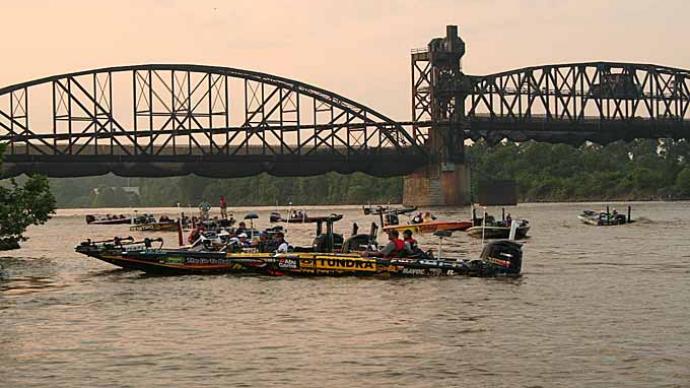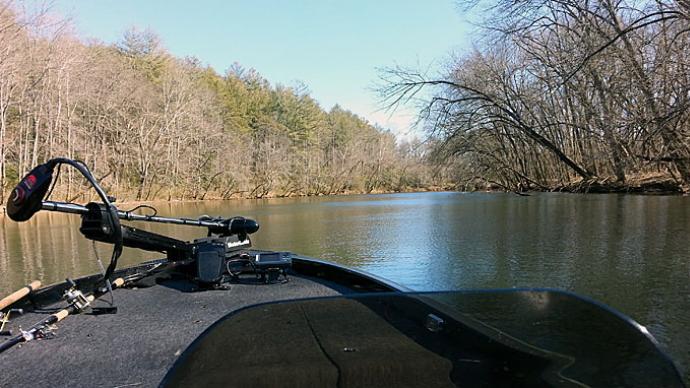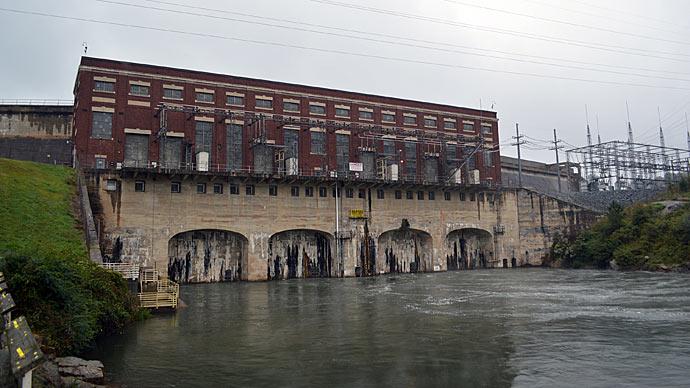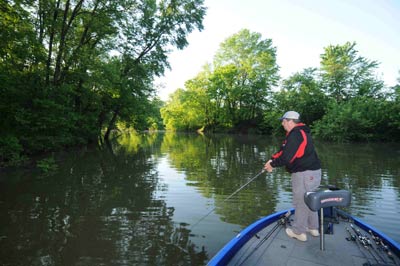
Bass fishing on rivers below dams is filled with plenty of highs and lows.
High and low water flow controlled by the dam authorities affects where bass will position in the river below. “The flow is pretty important because it positions the fish in the creeks and the points going into them,” Missouri guide Alfred Chapman says. “Once they stabilize the flow of the water to where it is not fluctuating up and down, those fish will lock in on that structure and stay there until they start dropping the river.”
Chapman guides on the Osage River below Lake of the Ozarks’ Bagnell Dam and has plenty of experience fishing the various flow stages of the river. Here is a look at how Chapman catches bass during the three flow stages of the river.
High Flow
When the dam floodgates are open, and the river is experiencing heavy flow, Chapman keys on banks with big rocks or any other large object in the water that provides a current break. The mouths of creeks also serve as current breaks where bass position in the eddies to feed.
“I try to position my boat off the end of the point at the mouth of a creek and throw up into the current and bring the bait down with the current as natural bait would come down,” Chapman says. Chapman prefers the down current presentation because it allows his lure to stay on the bottom better, whereas throwing downstream and bringing the lure against the current causes his bait to flow away from the bank and into deeper water.
Heavy flow from the dam usually occurs in the spring, so Chapman favors fishing farther away from the dam then. The dam area attracts plenty of anglers seeking crappie, walleye, and catfish, so Chapman prefers running downriver then to get away from the crowds and run up into the creeks for bass.
Chapman’s favorite lures for fishing in heavy current are a 1-ounce jig or a plastic worm, either Texas-rigged with a 1-ounce sinker or attached to a 1-ounce wobblehead jig. “The bait gets a lot of action from that wobblehead,” Chapman says. He prefers the heavyweight jig because it stays closer to the bottom in the swift current.
A jig is Chapman’s confidence bait for fishing in any water flow stage. “You can fish it 12 months out of the year, and you can fish it shallow or deep,” Chapman says. “So a jig is an all-around bait on the river.” His favorite jig for flipping into brush in the creeks is a 5/16-ounce Eakins Jig tipped with a Yum Christie Craw in green pumpkin or watermelon red flake for clear water or black and blue in darker water.
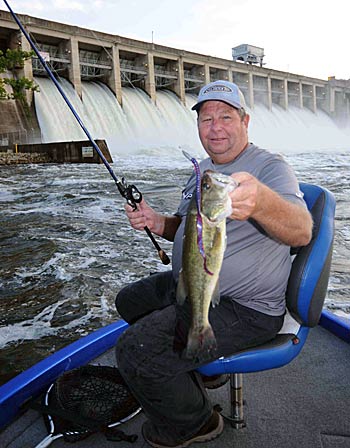
During heavy water flow, Chapman notices the weather has little effect on bass movement compared to other flow stages. “They are back in those creeks because that is where the shad are for the most part, so that is where they are going to go and stack up,” he says.
Moderate Flow
Bass tend to start moving around more when the flow starts slowing down. “Moderate flow is a little bit tougher,” Chapman says. “As long as it is stable and not fluctuating, you can go out on the main channel and again fish the hard banks with the big rocks for current breaks and things like that. The main thing is that the water level has to be stable and not moving up and down every few hours.”
Chapman will fish closer to the dam during periods of moderate flow in the summertime because he believes the flow from the dam creates more oxygenated and cooler water than the river has farther downstream. Baitfish and bass congregate in the cooler, oxygenated water closer to the dam.
During moderate flow, Chapman will continue to throw a jig or a soft plastic bait on a wobblehead jig, but he will also mix in a spinnerbait or crankbait to catch the most active fish. The size of his jig depends on the speed of the flow. Chapman usually starts with a 3/8-ounce jig, but if he has trouble keeping his lure in contact with the bottom, he keeps upgrading to a 1/2-, 5/8- or 3/4-ounce version until he finds the right size that stays close to the bottom but doesn’t constantly hang up.
Low Flow
There is always some water flowing from the dam, and during times of minimal flow, Chapman targets the main river structure, which could be in the middle of the river. “In the summertime, the bass want cool water and oxygen, so they are looking for shoals where they can get a lot of oxygen, and the cooler water is getting pushed out of, the deeper pockets.” Chapman then looks for any current flowing around rocks and logs in the river.
The river guide ranks summer as the best season for taking out clients because the water level on the lake above is stable, and the dam flow is minimal. This situation allows Chapman to see the cover on the main river so his clients can throw topwater lures around the exposed rocks and logs. Some of his favorite topwater lures for low-flow conditions are Whopper Ploppers or other prop baits, Zara Spooks, Rebel Pop-Rs, and hollow-body popping frogs. He also favors throwing a weightless Zoom Fluke for bass in weak current.
Knowing the flow from the dam before your fishing trip will help you determine how and where to fish the river. Chapman suggests calling the dam authority’s lake level phone number or checking the flow charts on the dam’s website to find out the current flow stage.
BassResource may receive a portion of revenues if you make a purchase using a link above.


